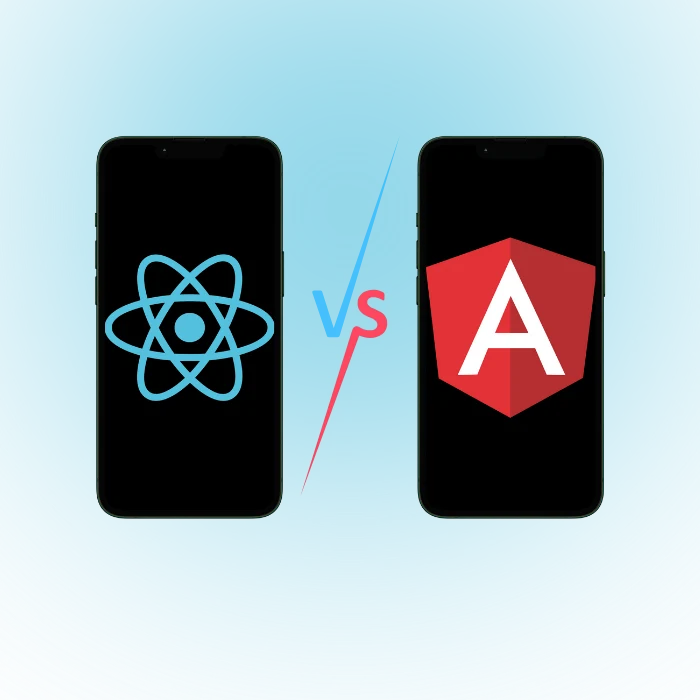Introduction
ReactJS and AngularJS are two of the most popular options for building modern web applications. Both enable developers to create dynamic, single-page apps that feel fast and responsive.
Choosing between these technologies can be a challenge, as each offers distinct strengths. Understanding their differences in design and capabilities is key to selecting the best fit for a project. In the following sections, we explore React and Angular — from core philosophy to ideal use cases — to help clarify the choice.
Choosing the Right Framework for Your Project
The choice between React and Angular depends on project requirements, team expertise, and long-term maintenance considerations:
- Choose ReactJS if you need a lightweight solution that you can get up and running quickly. Its ideal for projects requiring rich user interfaces and custom workflows. React is also popular when a project might expand to mobile development (using React Native).
- Choose AngularJS if you have a large, complex project needing a well-organized structure. Angular built-in features and strict patterns help maintain consistency across big teams. It shines when you need many features out of the box and want to avoid adding external libraries.
Expert Insight:
Seasoned developers often choose ReactJS for smaller, fast-moving projects and AngularJS for complex, enterprise-grade applications. Each aligns with different project needs and team preferences.
Which One to Choose
Both React and Angular are powerful but differ in approach. The table below highlights key differences across various aspects:
| Aspect | ReactJS | AngularJS |
|---|---|---|
| Type | Library (focused on UI) | Full-fledged framework (MVC/MVVM) |
| Data Binding | One-way (unidirectional) | Two-way (bidirectional by default) |
| Language | JavaScript (JSX optional, TS supported) | TypeScript (superset of JavaScript) |
| DOM Handling | Virtual DOM optimizes updates | Direct DOM with change detection |
| Architecture | Flexible; add libraries as needed | Structured; built-in modules & features |
| Performance | Fast UI rendering via virtual DOM | Good performance, heavier if not optimized |
| Learning Curve | Relatively easy for JS developers | Steeper due to many concepts and syntax |
| Ecosystem | Huge community; many third-party tools | Strong community; rich official tooling |
Understanding ReactJS and AngularJS
ReactJS is an open-source JavaScript library for creating user interfaces. It follows a component-based architecture, meaning UIs are split into reusable components. React introduced the virtual DOM, which updates pages efficiently by re-rendering only the parts of the UI that change.
In React, developers typically write components in JSX or plain JavaScript. Since React focuses solely on the view layer, building a full application usually requires adding libraries for state management, routing, and other features.
AngularJS is a full-fledged front-end framework created by Google. It uses TypeScript (a typed superset of JS) and follows an MVC/MVVM architecture. Angular introduces concepts like components, modules, services, and dependency injection to structure large applications.
Angulars templating system lets developers extend HTML with custom directives. By default, it supports two-way data binding, syncing the UI and data models automatically. Angular also includes built-in tools for routing, form handling, and more, providing everything needed out of the box.
Read Related Articles
- Learn more about single-page app architecture versus multi-page approaches in our blog Single Page vs Multi-Page Applications – a deep dive into SPA vs MPA design considerations.
- Explore the benefits of choosing Angular for building products to understand why many enterprises favor Angular for complex applications.
- Check out Top Front-End JavaScript Frameworks to see where React and Angular stand among the leading web development tools today.
Conclusion
ReactJS and AngularJS each offer a viable path to building modern front-end applications. There is no definitive answer for which is better — it truly depends on what you aim to build.
React provides simplicity and flexibility, allowing developers to mix and match tools as needed. Angular offers a complete, structured ecosystem that can keep big projects on track with less decision-making about external packages.
By weighing factors like project size, performance needs, and team skill sets, you can choose the framework that aligns best with your goals. Both technologies are mature and continue to evolve, so either way you will be using a proven solution for contemporary web development.






